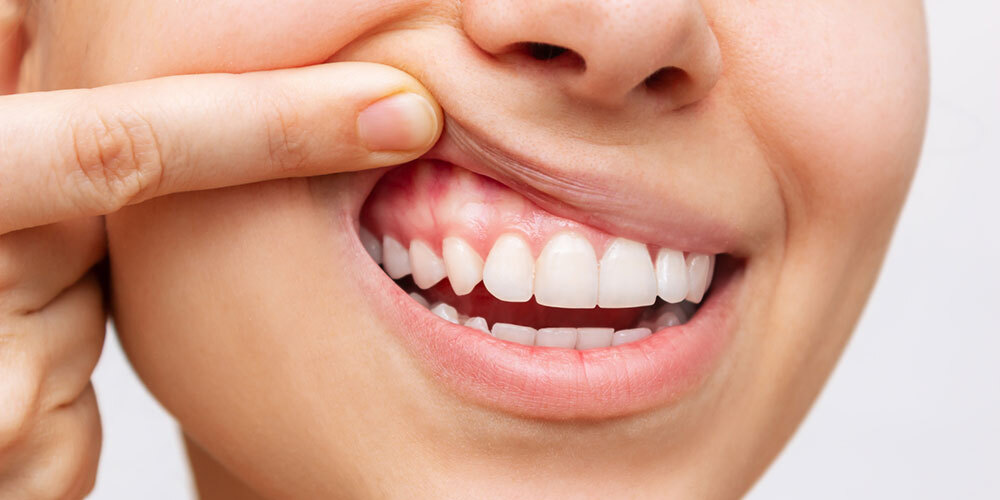
Why Does Gum Whitening Occur?
Gum whitening, also known as gum depigmentation, is often not merely a cosmetic concern but may present as a sign or symptom of underlying health issues. This change in gum coloration can occur for a variety of reasons, ranging from poor oral hygiene and inflammation to more serious conditions such as oral infections or autoimmune diseases. Given that the gums serve as a crucial indicator of one’s overall oral health, any discoloration—especially whitening—should be taken seriously. Whether the whitening is localized to a specific area or more widespread, it’s important to consult a dental healthcare professional for a thorough evaluation and appropriate treatment options.
Most Common Causes of Gum Whitening
Gingivitis:
Gingivitis is the inflammation of the gums. The gums become red, swollen, and sometimes take on a white color. This condition emerges as a result of plaque accumulation, insufficient tooth brushing, and lack of flossing.
Lesions and Ulcers:
Certain infections or injuries can lead to the formation of white lesions or ulcers on the gums. These situations may require treating the infections or facilitating the healing of wounds.
Oral Thrush (Oral Candidiasis):
Oral thrush is a fungal infection causing white lesions inside the mouth. Whitening can be observed on the gums or within the oral cavity.
Lichen Planus:
Lichen planus is an autoimmune disease that affects the tissues inside the mouth, including gums. It can result in white lesions or streaks within the oral cavity.
Anemia:
Anemia is the condition caused by an insufficient number of blood cells in the body. Patients with anemia may have white gums.
Leukoplakia:
This gum disease occurs due to smoking, alcohol consumption, or poor oral hygiene. Patients with leukoplakia also exhibit gum whitening. Biopsy may sometimes be conducted on these patients.
Teeth Whitening Treatments:
Following teeth whitening procedures, gums may temporarily whiten due to the effect of the chemicals or materials used during the process.
Dental Prosthetics and Restorations:
Incorrectly fitted or poorly made dental prosthetics or restorations (e.g., veneers or porcelain crowns) can lead to gum whitening.
Gum whitening may not always be a sign of a health issue, but it is important to consult a dentist or dental health specialist if you observe such changes. Early diagnosis of gum issues can make treatment more effective and help prevent more serious problems.
How Is Gum Whitening Treated?
The treatment for gum whitening depends on identifying the underlying cause and formulating an appropriate treatment plan. The goal is usually to improve oral health and restore the gums to their natural, healthy color. Here are some methods to treat gum whitening:
Improving Dental Hygiene:
Gum whitening often occurs as a result of poor dental hygiene habits. Regular tooth brushing, flossing, and using mouthwash can significantly improve gum health.
Professional Dental Cleaning:
A dentist or dental hygiene specialist can professionally clean your gums and teeth. This can eliminate plaque and tartar accumulation, reducing gum inflammation.
Gingivitis Treatment:
When diagnosed with gingivitis, a therapeutic plan is formulated to improve gum health. This may include a specialized gum care plan and, if necessary, the use of antibiotics or antiseptic mouthwashes.
Evaluation of Dental Prosthetics:
If dental prosthetics or restorations are causing the whitening, your dentist can make appropriate adjustments or replacements.
Antifungal Treatment for Fungal Infections:
For fungal infections like oral thrush causing gum whitening, antifungal medications may be used.
Treatment for Autoimmune Diseases:
In some cases, whitening could be the result of autoimmune diseases like lichen planus. These conditions may require more complex treatments and are managed by a dermatologist or specialist doctor.
The treatment for gum whitening may vary depending on its cause and severity. Paying special attention to gum health and following your dentist’s recommendations are among the best ways to prevent and treat gum whitening. Regular dental check-ups are also an essential part of early diagnosis and treatment.
